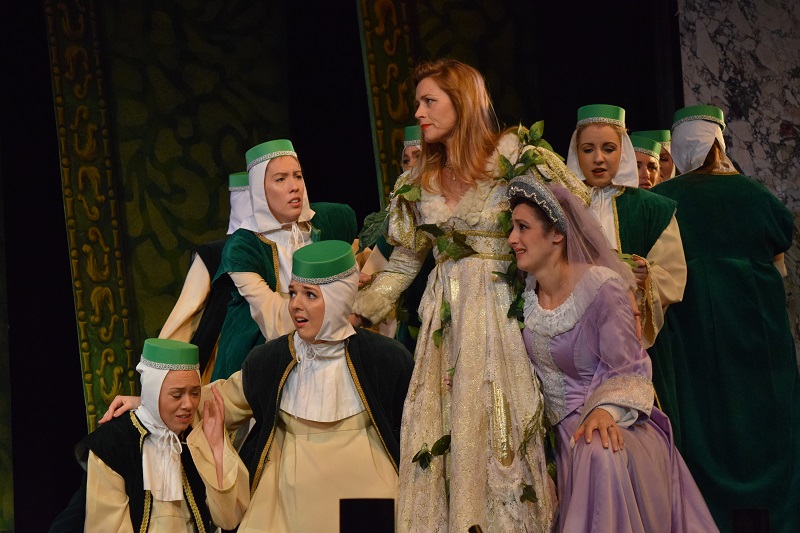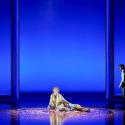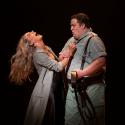I’ve said it before and I’ll say it again: you have to be pretty silly to take Gilbert and Sullivan seriously. But even sillier not to. And positively heroic to revive the pair’s 1884 three-acter Princess Ida: the show which – updated to a futuristic sushi bar – was responsible in 1992 for one of English National Opera’s all-time great fiascos (well, if you will hire Ken Russell as director...). Vivian Coates’s colourful new production for the National Gilbert & Sullivan Opera Company keeps the action firmly in the cod-medieval Neverland, lifted straight from Tennyson, that G&S specify.
But Princess Ida is still a problem piece, thanks largely to a plot whose cheerful mockery of such Victorian hot topics as female education and Darwin’s theory of evolution could easily prompt a 21st century sense of humour failure. If, that is, Gilbert (nothing if not an equal opportunity offender) hadn't spent the whole of Act One holding masculine vanity – whether King Gama’s spiteful bien-pensant meddling or Prince Hilarion’s limp sense of entitlement – up to even more savage ridicule. Gilbert’s real target – as ever – is the absurdity of trying to bend human nature to any rigid system or hierarchy. And as ever, where Gilbert provides the wit, Sullivan supplies the warmth. It’s very noticeable that the proto-feminist Princess is the only character who maintains much in the way of dignity. In the exquisite Act Two quartet The World is But a Broken Toy, the battle of the sexes is temporarily laid aside in a wry acknowledgment of common human folly: but it’s Ida’s voice that soars above the three men.

And it certainly soared in this performance at the Malvern Theatres; Emma Walsh’s soprano as Princess Ida (pictured above) blending luminously with Nick Sales (Cyril) Matthew Kellett (Florian) and Laurie Slavin (a winningly light-voiced Prince Hilarion). These four were the heart of a cast studded with Savoyard royalty. Gaynor Keeble – a lacerating Kostelnicka at Longborough last year – clearly enjoyed letting her battleaxe flag fly as the scheming Lady Blanche, maintaining an imperious hauteur even while wearing a broom on her head. Richard Suart (pictured below) and Donald Maxwell, meanwhile, were a little‘n’large dream team as Kings Gama and Hildebrand respectively. Suart ought to be listed as a national treasure: channelling Olivier as Richard III and cackling and lurching about the stage on his crutches like some malignant rubber-faced spider. But even the smaller roles were wittily characterised. Natalie Montakhab was an enjoyably mischievous Lady Psyche, and James Cleverton, Matthew Siveter and Stephen Godward managed to project a certain lumpish amiability even while clanking about the stage in full armour as Gama’s thick-as-mince soldier sons.
There was never any question of an ensemble cast this good letting the music do all the work, and Coates drew some richly comic moments from the spoken dialogue too – so important in G&S. When not singing, Walsh projected the brisk, no nonsense manner of Miss Jean Brodie, and there was a definite Carry On vibe about Florian, Cyril and Hilarion’s cross-dressing antics. Smart, lively choreography by Mary MacDonagh complemented some sonorous choral singing, and the operetta-medieval costumes – ranging from doublet and hose for the chaps to some extraordinary disco Valkyrie numbers for Ida’s all-girl army – helped distract from the slightly pantomime-ish scenery.
I’m afraid the scenery was one area in which – unlike King Gama – I definitely have something to grumble about. There’s no overwhelming need for a new G&S production to go down the route of a Jonathan Miller-style updating (still less a Ken Russell one), but a cast and a director as classy as this deserve something a bit more imaginative, a bit better made, than unconvincing painted flats. It doesn’t need to be costly, as long as it doesn’t look cheap. And then there’s the orchestra, which sounded bigger and better nourished than on previous NGSOC tours, and proved capable of some extremely eloquent playing (the woodwinds, in particular, really bubbled).
But while Aidan Faughey, conducting, kept things bustling along nicely and could deliver an infectious rhythmic kick, there was an overall coarseness of texture, coupled to an occasional raggedness, which prevented Sullivan’s score from working its full magic. English Touring Opera’s Patience earlier this year demonstrated how glorious this music can sound when played with absolute finesse. The NGSOC is doing valuable work with first rate but under-served repertoire, and this hugely enjoyable Princess Ida demonstrates how they continue to raise their game. But the grace, subtlety and melodic invention of Sullivan’s music is only a hair’s breadth from Mendelssohn; and through him, Mozart. No matter how topsy-turvy the action on stage, G&S needs to be conducted like it’s The Marriage of Figaro. Accept nothing less.















Add comment